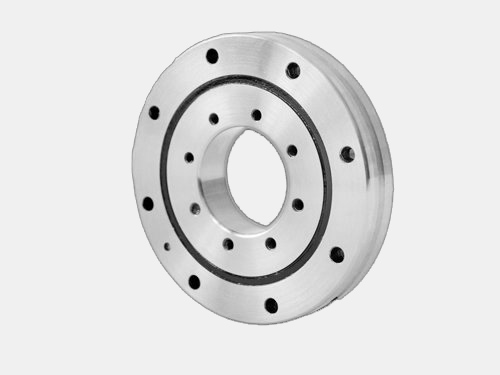The preloading of bearings can effectively prolong the service life of bearings, improve their running accuracy and rigidity, and reduce deformation. As a kind of high-precision bearing, YRT turntable bearings also need to be preloaded to a certain extent during installation. However, if the preload cannot be adjusted properly, it will instead accelerate the deformation and failure of the bearings. So how to determine the preload of YRT turntable bearings? The following are the specific methods for determining the preload, which are sorted out by Guoyang Precision Machinery Bearings for your reference.
1. Use a spring scale or a simple force measuring instrument. During the assembly process, fix the bearing and the rotating shaft firmly and ensure that the shaft can rotate. Then, place the spring scale or the simple force measuring instrument on the shaft. Apply a pulling force along the tangential direction of the shaft with the spring scale. The inner ring and the shaft rotate together. When the reading reaches a stable state, it is the final measurement result. Multiply the measured force value by the distance from the tangent to the axis of the shaft, and the resulting value is the preload torque value of the bearing on the main shaft.
2. For paired bearings, there are requirements for the friction torque. When the bearing type, internal parameters, lubrication method, etc. are fixed to a certain extent, there is a certain corresponding relationship between the friction torque of the bearing and the axial load. Therefore, when determining the preload, the friction torque of the bearing can be referred to. Thus, by calculating the friction torque of the paired bearings subjected to the preload, and comparing the calculation result with the measured value of the actual friction torque, it is possible to determine whether the internal preload of the bearing meets the requirements.

Before installing the bearing, use a test system similar to the actual installation to pre-install the bearing. Install the bearing in the mechanism, apply the required axial preload after conversion, and measure the actual distance of the bearing. The measured value is the actual size value required during assembly after the preload is applied to the bearing. This value includes the actual distance of the bearing and the clearance adjustment size after the preload is applied to the bearing. Machine the length of the spacer according to the actual distance of the bearing.
During the actual installation process, strictly control the fit between the inner hole of the bearing and the shaft. The fit between the inner ring of the bearing and the journal must be neither loose nor too tight, and the inner ring should be able to move axially flexibly. When assembling the inner and outer rings, it is appropriate that they can just be pushed into the fit at the journal and the bearing seat hole with both thumbs. Then, by adjusting the size of the sleeve and the size of the outer bearing cover, ensure the actual assembly size. If necessary, during the size adjustment process, adjustment shims of fixed sizes can be added to ensure that the value of the bearing preload is close to the predicted value.
Pre-measure the relationship between the friction torque and the axial load of the bearing. Place the bearing on a circular seat body. Through formula conversion, a load equal in magnitude to the preload can be applied to the inner ring of the bearing by controlling it with gravity or spring pressure. After the bearing is subjected to the force, an axial dimensional difference, namely △K1 and △K2, appears between the inner and outer rings, and the value is measured with a dial test indicator. When assembling the bearing, the preload of each assembled transmission shaft bearing should be inspected with a special dial test indicator. If the applied preload is insufficient, gaskets can be added for adjustment to fix the clearance size of the bearing, thus ensuring that the preload is within a fixed range.

为了消除轴承内外环间隙,依靠螺母进行轴向固定的轴承,可以通过螺母扭转轴向压紧轴承内环,到达轴承预紧的目标。这种办法是比较通用的办法,其构造简单,适用性强,这样预紧轴承的预紧力易于控制,缺陷是无定量数据。但是经过测量终的装配轴向尺寸,加入适当的垫片,就可调整预紧力的大小。为了提高生产效率和装配精度,生产中通常借助定力矩扳手完成装配。定力矩扳手主要特征就是:可以设定扭矩,并且扭矩可调。定力矩扳手既可初紧又可终紧,它的使用是先调节扭矩,再紧固螺栓。在轴承的装配过程中,可进行预装配,获得预紧力所需要的拧紧力矩,然后进行装配。
在要求较高的装配过程中,可以借助传感器实现测控。现代传感器技术的飞速进步,使测量变得越来越简捷。在轴承的装配过程中可以选用转矩传感器。转矩传感器是将专用的测扭应变片用应变胶粘贴在被测弹性轴上,并组成应变桥,向应变桥提供电流即可测得该弹性轴受扭的电信号,将该应变信号放大后,经转换,变成与扭应变成正比的频率信号。得到的信号经过相关仪器或计算机处理便可显示出转矩值。借鉴以前的安装方法,固定轴旋转轴承座进行测量。运用按有转矩传感器专用的机械夹具夹持,在驱动设备的驱动下使轴承座体跟随测量机共同旋转,可以测量出该夹具所受的反作用力矩值,即轴承预紧力矩值。常见的驱动电机即可以充当驱动设备提供动力。
关于YRT转台轴承如何确定预紧力,除了以上国扬精机的小编为大家整理的方法外,对于轴承的预紧力确定方法,其实还有一种依靠技术工人的经验检测法,这种方法主要靠工人双手对阻力矩和轴承转动灵活性的感知,对有经验的人来说十分简单,但是工作效率较低,而且劳动强度较大,并不适合高精度的YRT转台轴承。